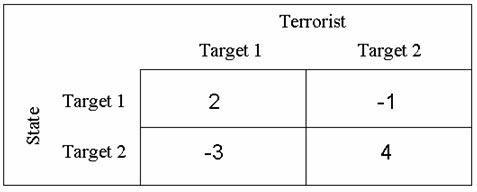Defence against Terrorist Attacks: Game Theory can Help
Counter-terrorism has become a key research area in the wake of the heightened threat posed by terrorist groups in various parts of the world. In this context, game theory, a branch of mathematics concerned with decision-making, can offer useful insights to improve the customary practice in defending against terrorist attacks. It applies to situations (games) that involve two or more people (players) each attempting to choose between two or more ways of acting (strategies). Game theory has found its best application in the development of models of deterrence. To date, it has earned more than twelve game theorists the Nobel prize. The objective of game theoretic modeling is to precisely trace through the logic of strategic situations – to explain why people behave in certain ways and to predict their future behavior. The basic assumptions behind the theory are: (1) people form beliefs about the behavior of others, (2) people best respond to their beliefs, (3) there is common knowledge among players. Therefore, in a game, each player chooses his or her own optimal decisions while considering what the others will do in the presence of strategic uncertainty. To give an example, when game theory was applied to understand and explain the possible actions (of the two super powers) and outcomes in the Cuban missile crisis of 1962, it was concluded that a determined but non-provocative response would better induce the Soviet Union to agree to withdraw the missiles and bring the crisis to a peaceful resolution.
In case of counter-terrorism, game theory can provide ‘solutions’ based on the probability of choices. To illustrate this further, a simple game between ‘a terrorist group’ and ‘a state’ is defined in Table 1. In situations of conflict, though both players realize that they are jointly better off, each still chooses to seek individual endeavour. Since the players select their strategies simultaneously and independently, conflict and cooperation overlap. Now assume that the terrorist decides to attack either target 1 or target 2, but not both. It is in the state’s facility to prevent an attack on target 1 or target 2 by appropriate defensive measures, or it could attempt to prevent both at somewhat greater cost. It is assumed that the consequence of choosing a particular strategy is a numerical payoff (or profit) to each player, which is based on rough reasoning. The mathematical problem here is to estimate the probability of choices for the state in order to maximize its utility. To see how both players will play the game, let us suppose that in the first instance the terrorist group chooses to attack target 1 and the state also chooses to defend target 1. In this case, the success of the state is recorded as a payoff of 2 in Table 1. Now suppose the state continues to choose target 1, but the terrorist group shifts its choice to target 2, in this case the negative payoff 1 implies state failure. However, suppose after a while the state realizes that the terrorist is consistently focusing on target 2, it would concentrate on defending target 2 and thereby gain the payoff of 4 (Table 1), and so on. At the end of the game, we are interested in finding the best way for the state to defend these targets.

Table 1: Strategies for the terrorist group and the state
Now, suppose, that the state chooses to defend target 1 with probability p1 and target 2 with probability p2. In case the terrorist group attacks target 1, the state will gain,
On the other hand, if the terrorist group chooses target 2, the state will get,
In order to maximize the state’s utility, the simple linear programming problem is to maximize u such that,

Assuming p1+ p2 = 1, the values of p1 and p2 can be calculated as 7/10 and 3/10, respectively. This implies that if the game is played ten times the state should choose to defend target 1 and target 2, seven and three times respectively, in order to maximize its response. It is to be noted that in real life situations there can be n number of targets instead of the simple choice of two. Also, the numerical value of payoffs would be entirely dependent on the importance of the targets. To sum up, game theory based on mathematical formulations, mirrors the real-life choices. By postulating that the players think ahead not just to their immediate consequences, but also to the others, it can provide a framework to think about defending against terrorist attacks.







